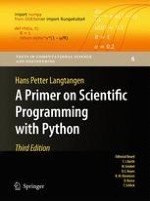2012 | OriginalPaper | Buchkapitel
7. Introduction to Classes
verfasst von : Hans Petter Langtangen
Erschienen in: A Primer on Scientific Programming with Python
Verlag: Springer Berlin Heidelberg
Aktivieren Sie unsere intelligente Suche, um passende Fachinhalte oder Patente zu finden.
Wählen Sie Textabschnitte aus um mit Künstlicher Intelligenz passenden Patente zu finden. powered by
Markieren Sie Textabschnitte, um KI-gestützt weitere passende Inhalte zu finden. powered by
